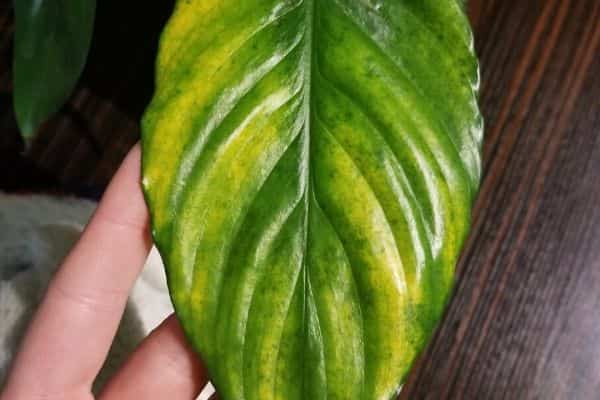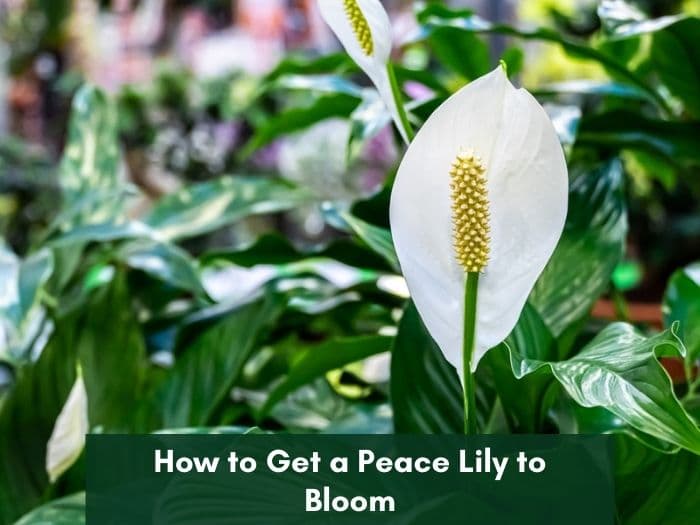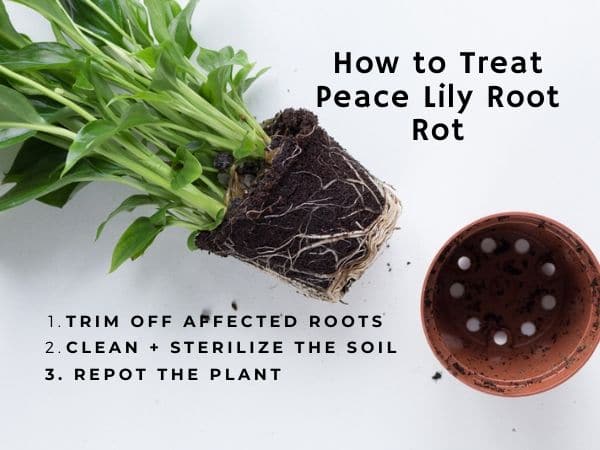Signs of an Overwatered Peace Lily and How to Revive It
Peace lilies are among the best indoor plants because of their minimal care and ability to bloom reliably. They are, however, quite sensitive to changes such as overwatering, too much fertilizer, and improper light. What are the signs of an overwatered peace lily, and how can you revive and make it recover?
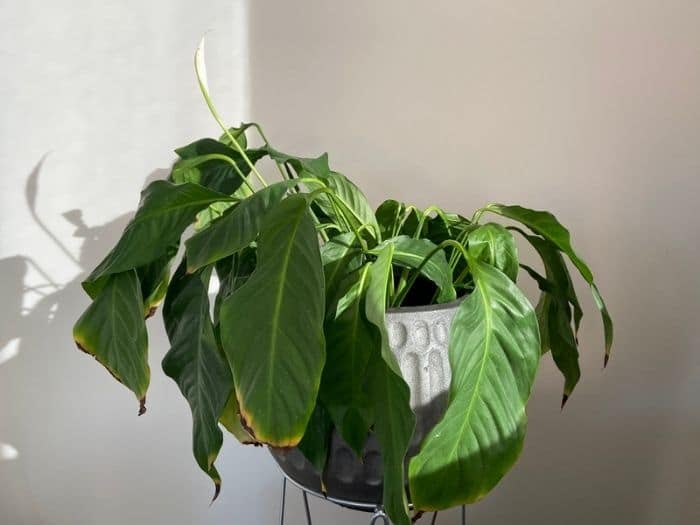
Signs of an overwatered peace lily include drooping, leaves turning yellow, brown tips, and root rot from suffocation. To revive and save the peace lily, move it to a shaded spot, treat root rot, and then repot it using a fresh potting mix. Ensure the pot has a draining hole to prevent waterlogging.
Peace lilies grow in tropical forests but not in swampy regions. Too much light and overwatering will make the plant droop.
If overwatering is not remedied on time, it will eventually kill your peace lily since it’s simply drowning its root system. Luckily, you can revive it with a few peace lily care tips I’ve explained below.
Signs of an overwatered peace lily
So how do you know you have overwatered your plant? What does an overwatered peace lily look like?
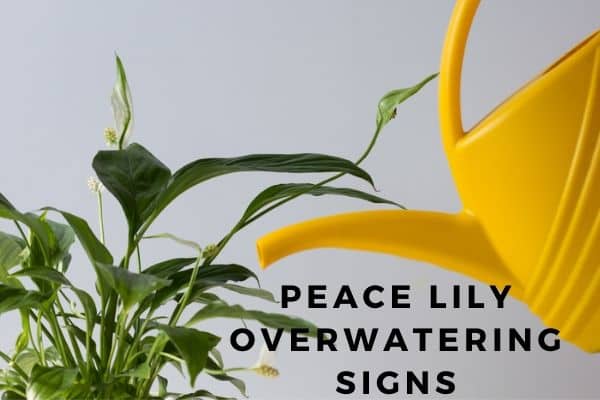
The peace lily will look like it’s starting to wilt and will discolor with yellow and brown leaves, grow slower than usual, and the roots will start to rot due to fungal infections in soggy conditions.
The symptoms of overwatering your peace lily include the following:
- Brown-edged leaves.
- Black-tipped roots that have a skimpy appearance.
- Brown leaf tips
- Yellowing leaves
- Wilting and drooping peace lily leaves
- Stunted growth
- Black and weak roots
If the plant is diseased, the symptoms of the disease will appear alongside these two signs. The good news is that you can revive a dying peace lily by following a great recovery plan I have explained below.
How you can heal the overwatered peace lily
After fixing your watering routine, you can heal the dying peace lily in the following ways:
1. Stop watering the plant
The soil already has too much water; adding more will worsen the problem. The first step to reviving the plant is to stop giving it more water and allow the excess of it to drain out of the pot.
2. Treat root rot disease
If you observe any other symptoms beyond the ones specific to overwatering, you should have samples of the plant tested to find out the disease affecting the lily. The lab should then recommend the required treatment regime to revive your peace lily.
Uproot the peace lily, then cut off any rotting roots. Apply a weak hydrogen peroxide solution on the remaining roots to kill the fungus. Repot the plant using a new potting mix and place it under a shade to recover.
3. Cut off affected leaves
The affected leaves, which will change color, should be cut off at the base of the stem. If the leaves are only wilted and unaffected by disease, don’t cut them off since they’ll likely recover.
4. Follow a good peace lily care plan
Besides watering issues, check whether you’re keeping the plant’s care routine regarding fertilization, humidity, temperature, and sunlight.
These exercises, when performed well, will see your droopy peace lily recover to green, turgid leaves. It may take up to 2 weeks for the plant to recover from this episode.
How to fix and prevent overwatering
The first step in fixing the overwatering problem is changing the watering routine or using 14-day watering globes. The plant usually only needs water when its leaves are slightly wilted. Otherwise, normal periodic watering could still be too much for it.
The second step is to ensure the plant’s pot has a drainage hole about midway from the bottom. This way, even if you gave it too much water, the excess would simply drain out and leave only the lower part with large amounts. As the roots of the peace lily rarely grow that deep, it won’t be affected.
The third step is to avoid watering your peace lily at night. Your lily is more likely to get diseased when watered at night than during the day.
One foolproof way to know when to water the plant is by using a water moisture sensor. You simply stick its end into the soil and take a reading.
For the peace lily, the best reading should be around 7. If it goes to around 4, it’s time to water it. If more than 7, you’re giving the plant too much water.
Pro tip: If you don’t have a water sensor, poke your index finger into the soil around the plant up to the second knuckle, then pull out some soil. If you can’t make a ball with the soil, it’s too dry and needs watering. If you can make a ball with it but can’t squeeze water from it, then it’s just right. If you can squeeze water from this ball, it has too much water.
If you’re traveling and you’re not sure how long your peace lily will stay without water, I recommend using watering globes that last up to 14 days to keep the spathiphyllum hydrated.
Overwatered vs. underwatered peace lily
But before you apply all these fixes, are you sure your plant is overwatered or underwatered? These two signs can overlap, so you may be dealing with either problem.
Here’s how to tell overwatering vs. underwatering:
| Overwatering | Underwatering |
| The soil is soggy, but the plant is droopy. | The soil is dry, and the plant is wilting. |
| Leaves turning yellow but not dry. | Leaves turn yellow, dry, and crispy |
| Leaves may form black blotches. | Leaves turn brown from the tips. |
| Moldy soil due to fungal growth. | Dry, hard soil. |
| Mushy roots | Brittle roots when uprooted. |
Is it bad to overwater a peace lily plant?
When it comes to peace lily care, overwatering is not recommended because soggy conditions cut off oxygen supply. Your plant will not get adequate oxygen to grow healthy and survive.
Too much water usually leads to fungal infections in potted plants. Root rot will manifest as brown to black root tips, altered texture, and oozing sap. When identified and fixed early, peace lilies can recover from overwatering symptoms.
Overwatering your peace lily is a bad thing for the following reasons:
It chokes the root
Only plants adapted to swampy conditions, such as the mangrove, can survive when there’s too much water in the ground. Giving your peace lily too much water results in soaked soil conditions, making it hard for the roots to breathe.
If the roots can’t breathe, they’ll not function normally. The result is poor health for the plant since the roots take in water and nutrients for it to thrive.
It leads to fungal disease
When your peace lily’s health deteriorates due to the poor root system, it becomes highly susceptible to diseases. There are many types of fungi, and they manifest as root rot in houseplants in different ways. They include:
Cylindrocladium
The signs of this disease include the yellowing and wilting of leaves in their lower sections. The petioles (the stalk between the stem and the leaf) may also turn dark brown in color. The roots may also turn black and spongy and may even peel off.
Rhizoctonia
This fungus can be identified by its fine webbing and brown spots on the leaves. Stems will likely collapse due to the brown and sunken lesions at the bases. It usually affects the leaves, stems and roots.
Phytophthora
Phytophthora manifests as small yellow leaves that wilt. Eventually, the tips of the roots change color from white to black, brown, or gray.
Pythium
Pythium is a water mold that can cause root rot and damping off in plants. It is found in soil and water, and thrives in wet conditions. The symptoms of Pythium can vary depending on the plant and the severity of the infection.
Symptoms include brown or black lesions on the roots, wilting, yellowing foliage, and stunted growth.
All these diseases lead to rotting roots and may require lab tests to find out the right one. Their symptoms occur other signs of overwatering the plant.
FAQ
What if I forget to water my peace lily?
If you forget to water your peace lily for a few days, water your plant thoroughly and let it soak up the water. However, if you forget to water your peace lily for an extended period of time, the leaves may start to turn yellow. Water your plant well and cut off the yellowing leaves if this happens.
What kind of water should I use to water my peace lily?
Peace lilies prefer to be watered with room temperature water. You can use tap water, but it’s best to let it sit out for a day or two before watering your plant. This will allow the chlorine and other chemicals in the water to dissipate.
Video
Conclusion
Overwatering is one of the most common problems with peace lilies. If you overwater your plant, the roots will start to rot. This can be fatal for your plant. If you think you may have overwatered your peace lily, check the roots. If they are brown and mushy, you’ll need to repot the plant in fresh potting mix.
MORE ABOUT PEACE LILIES
- How to Prune a Peace Lily
- FIX: Peace Lily Leaves Turning Brown
- Why do peace lily leaves turn yellow?
- How to Make a Peace Lily Bloom
References
- David Graper, Horticulture Specialist, SDSU Extension: Care of Peace Lilies
- D. J. Norman, Ph.D, University of Florida IFAS: Diseases of Spathiphyllum


